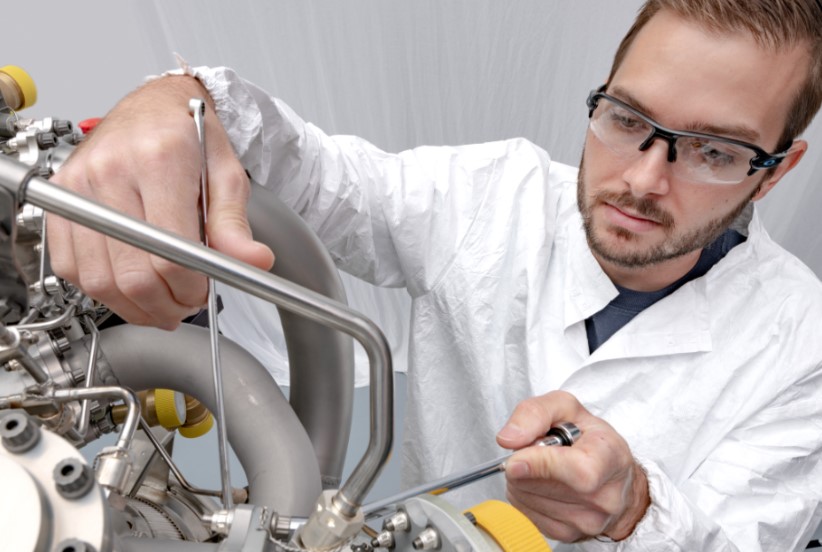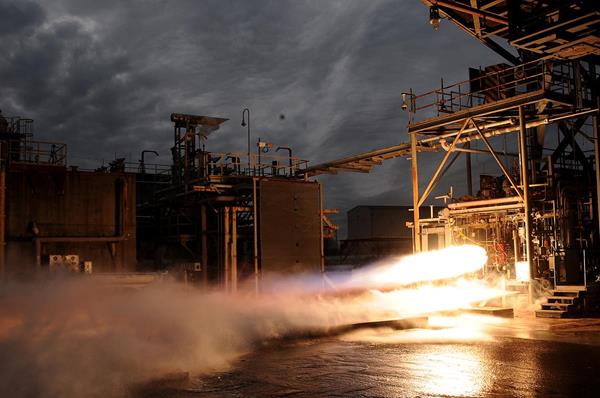U.S. propulsion system manufacturer Aerojet Rocketdyne has announced that an upgraded version of its RL10 rocket engine has successfully passed NASA hot-fire testing procedures.
During the trials, the company’s new RL10C-X upper-stage engine, featuring an additive manufactured injector and combustion chamber, demonstrated ignition and long-term durability within in-space simulations. Developed alongside the United Launch Alliance (ULA), the RL10C-X has been built to propel its next-gen Vulcan Centaur launch vehicle, as part of upcoming exploratory space missions.
“Successfully completing this test series validates our approach to incorporating 3D printing technology into the RL10 program in order to reduce cost while maintaining the engine’s unmatched performance,” said Eileen P. Drake, CEO of Aerojet Rocketdyne. “The RL10 has been a workhorse in the industry for nearly six decades and the RL10C-X will help ensure the engine maintains this leadership position.”

Aerojet Rocketdyne and 3D printing
In addition to rocket engines, Aerojet Rocketdyne is also known as a manufacturer of missile defense and tactical systems, which serve the needs of U.S-based clientele and agencies abroad. The firm has worked for over 20 years to integrate 3D printing into its production process in a way that yields spaceflight-ready parts, making advances in reducing product cost while increasing design complexity.
Back in March 2017, Aerojet Rocketdyne renewed its commitment to using Sigma Labs’ PrintRite3D software, which has since served to expedite its certification workflow. The company has also integrated a 3D printed preburner into its AR1 rocket engine, and hot-fire tested it, in addition to completing its Critical Design Review (CDR) later in 2017.
More recently, Aerojet Rocketdyne acquired 3D Material Technologies (3DMT), in a move that saw it incorporate the firm’s 3D printing, CNC machining and MIM capabilities into its portfolio. Leveraging its additive manufacturing expertise, the company now makes critical parts for the RS-25 engine as well, and it recently received a $1.79 billion contract to create 18 of the systems for NASA’s ‘SLS project.’
Mission-testing the RL10C-X
First tested in 1959, Aerojet Rocketdyne’s long-serving RL 10 engine has launched hundreds of satellites, exploratory spacecraft and landing vehicles over the years. In that time, the system has undergone nine major upgrades, and given that it has a deep-throttling capability down to 10% of rated thrust, the engine continues to have utility as a means of powering NASA’s large lunar lander missions.
In order to ensure the propulsion system’s ongoing efficacy, Aerojet Rocketdyne has been working with the ULA and U.S. Air Force to develop its enhanced RL10C-X model for at least four years. Initially, the company 3D printed and tested subscale components in 2017, before successfully integrating a nickel additive-manufactured regeneratively-cooled nozzle into the rocket’s thrust chamber assembly.
Once Aerojet Rocketdyne had established a production-ready engine configuration, it carried out a full-scale sea-level test in April 2019 without incident, and it has since been started a total of 32 times. In the firm’s latest evaluation, the RL10C-X was subjected to two hot-fire altitude tests, which were conducted within a vacuum to simulate in-space conditions.
The 3D printing-optimized engine proved capable of igniting and delivering 24,000 pounds of thrust, while enduring multiple restarts and operating for lengthy periods. Having now racked up more than 5,000 seconds of full-engine hot-fire test time, the RL10C-X is set to be used as a means of powering the ULA’s Vulcan Centaur rocket, which was added to NASA’s space launch vehicle catalogue in April 2021.
“The outstanding progress we’ve made on this program demonstrates the maturity of the entire RL10C-X engine system for operational use,” said Jim Maser, Senior VP of Aerojet Rocketdyne’s Space Business Unit. “It not only demonstrates the capability and robustness of the RL10 design, but also the tremendous depth of experience this team has with hydrogen engine development and evolution.”

3D printing’s space race
In order to power its future space missions, NASA is increasingly turning to those private aerospace firms using 3D printing to develop rocket engines with enhanced in-flight capabilities. For instance, earlier this year, 3D printed rocket manufacturer Relativity Space was awarded a $3million NASA contract to launch small satellites into orbit.
NASA itself has also conducted research into additive manufactured engine components, completing 23 hot-fire tests of a copper combustion chamber and iron-nickel superalloy nozzle in December 2020. During evaluations, the optimized DED-printed parts proved capable of withstanding more extreme heat than their conventional counterparts.
Elsewhere, working with Johns Hopkins University, NASA scientists are taking a different approach altogether, and experimenting with a solar-propelled rocket design. The researchers are currently exploring the possibility of using metal 3D printing as a means of optimizing the unit’s heat shield.
To stay up to date with the latest 3D printing news, don’t forget to subscribe to the 3D Printing Industry newsletter or follow us on Twitter or liking our page on Facebook.
Are you looking for a job in the additive manufacturing industry? Visit 3D Printing Jobs for a selection of roles in the industry.
Featured image shows an Aerojet Rocketdyne engineer preparing the company’s RL10C-X rocket engine for testing. Photo via Aerojet Rocketdyne.



